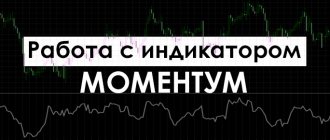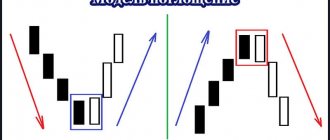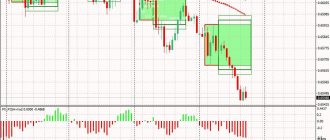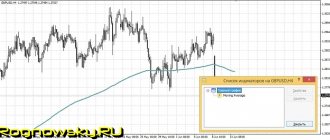Hello, fellow traders! I am often asked: does technical analysis work? Which Forex indicator is the best?
There is no better indicator. But if I were asked to choose only one element of technical analysis in Forex, which carries the greatest power, then I would choose divergence.
What is divergence in Forex?
What is divergence?
You might be wondering, what is divergence? You may have a guess, or you must be one of the few who actually knows what this signal is. Divergence is an early sign of how the market will behave in the near future. At the moment of its reversal, the market, as a rule, reaches its peak and lets us know that it no longer has the strength necessary to continue its movement in the same direction.
As an interpretation of this term, the dictionary provides a short list of the following related words: Change of direction, deviation, divergence and disagreement.
During trading in the Forex market, the phenomenon of divergence emerges, which is reflected in the following: “the direction of movement of the indicator diverges from the direction of price movement.”
To a greater extent, this phenomenon is reflected by such indicators as MACD, stochastic oscillator and RSI. You may also see divergence on other indicators that you would never have thought could show it.
As you know, the market moves in an up and down direction, even in a trend. The oscillator strictly follows the price movement. If the market moves up, the oscillator also moves up. When the market makes a higher high, the oscillator also makes a higher high.
Divergence occurs when the market makes a high high on the chart, but the oscillator that is closely following it does not show a higher high, but instead makes a lower high! This clearly demonstrates a situation where the oscillator indicates that the market has weakened and that there is a high probability that a price correction (pullback), or even a market reversal, will occur in the near future.
The market makes a higher high, but the indicator makes a lower high!
The divergence in the example above is called classic bearish divergence. We will gradually introduce new terms and their interpretation. With this example, we show you the point that indicators do not always reflect the trend in the market. And we can take advantage of this divergence to open a position!
A similar situation can occur in a falling market. If the market makes lower lows, the indicator also shows lower lows. If there is a discrepancy between the price chart and the indicator, we assume a possible change in direction.
The market makes a second lower low, however the indicator makes a higher low!
The divergence described above is called classic bullish divergence. The term "bullish" refers to the direction the price chart will take after a divergence.
- Bullish if the market then goes up.
- Bearish if the market then goes down.
Indicators for searching for models
It was said above that divergence (bullish or bearish) manifests itself on any oscillators. Beginners are often interested in the question of which indicator is used to consider such a model the most reliable. Experienced traders and most experts consider using the MACD indicator preferable for this purpose.
The main reason for this is the absence of the so-called in this indicator. "saturation zones". They are inherent in most oscillators (such as stochastic, RSI, CCI), since even the best indicators use calculation algorithms that require artificial delimitation of values (for example, for Stochastic and RSI at levels 0 and 100%). This introduces errors in determining divergences and interpreting signals.
However, indicators that use overbought (oversold) zones also have an undeniable advantage. According to the rules of technical analysis, all events that occur while the oscillator is in these areas are usually perceived as strong. Accordingly, we can talk about an increase in the strength of divergence signals during the formation of models in the corresponding zone.
In addition to oscillators, excellent results are shown by techniques using divergences (convergences) obtained when working with volume indicators.
Video: MACD divergence
Different types of divergence
Previously, we looked at the possibility of trading both types of trends using various counter-trend trading techniques. There are different types of divergences.
The most common type of divergence is counter-trend divergence. Many traders have some knowledge of counter-trend trading techniques. Because these techniques are so common in regular trading, this type of divergence is called classic or ordinary divergence. Other trading systems used by traders are sometimes based on the same ordinary divergence, but the trader simply does not comprehend its presence in it. In this guide, we will help you gain a deeper understanding of trading techniques and you will identify divergence in your trading strategies, along with applying other trading principles.
Types of divergences
1. Classic or regular divergence
2. Hidden divergence
3. Extended divergence
Classic divergence is the most common; it occurs when a trend reverses.
Hidden divergence is known to approximately 25% of Forex traders who use regular divergence. Hidden divergence is a sign of trend continuation.
Extended divergence is also a sign of trend continuation. Few people know about this type of divergence. However, it is a powerful signal that can be used in trading.
The theory of convergence in trading: how to define it and what does it mean?
Convergence is a good signal about the mismatch in the movement of Japanese candlesticks when updating lows and oscillator readings. On the chart it looks like when a new price low updates the previous one, and the oscillator consistently increases the lows.
Convergence is also called bullish divergence because it is a mirror image of the classic one. In a downward trend, the indicator signal and the price movement converge, after which an exact trading command is issued to buy the asset.
The diagram represents how trend lines constructed from peaks converge. When extended, it is clear that they will converge at one point. On the real chart this long situation is represented:
The figure shows how the exchange gave two entry points and turned around according to convergence.
Classic divergence
Regular divergence is one of the types of divergence that foreshadows a trend reversal in the Forex market and can be a signal to open a long (buy) or short (sell) position.
- A normal bearish divergence indicates that the price chart is about to go down, be prepared to sell.
- A normal bullish divergence indicates that the price on the chart is about to go up, be ready to buy.
Classic bearish divergence:
In order to identify normal bearish divergence, we must look at the highs, or peaks, of the price chart and indicator. A typical bearish divergence occurs when the price chart makes a higher high and the indicator makes a lower high. To do this, it is not at all necessary that there be a series of higher highs on the price chart (in the market); it is enough to see one higher peak compared to the previous one. If the indicator shows divergence, then this is a signal for a possible downward movement, which we can use to open a sell position.
Classic bearish divergence
The dotted lines help you determine whether the second high is above or below the first.
Classic bullish divergence:
In order to identify normal bullish divergence in forex, we must look at the lows, or lows, of the price chart and indicator. A typical bullish divergence occurs when the price chart makes a lower low and the indicator chart makes a higher low. Similar to what was said earlier, this does not necessarily have to be a series of lower lows on the price chart; it is enough to see one lower minimum compared to the previous one. If the indicator shows divergence, then this is a signal of a possible upward movement, which we can use to open a buy position.
Classic bullish divergence
The dotted lines help you determine whether the second low is above or below the first.
As you can see from these examples showing divergence, in most cases, you will see a line connecting the first high (or low) to the second high (or low), on both the price chart and the indicator. This is the best way to clearly detect divergence. In the future, you will see the divergence visually, but for starters, while you are just starting to master this signal, connecting lines will greatly help you with this. I have been using divergence as a market entry signal for many years, but even today I still draw these guide lines on my charts.
Redrawing
The question is always relevant: at what point is it correct to assess the situation? After all, the indicators depend on the price and are adjusted when the market accelerates. And tools with a delay - without redrawing; in the cryptocurrency market they often give a signal when everything is already over.
- For relatively objective confidence, you need to wait for two candles after the expected extreme.
- This arrangement does not 100% guarantee that the peak has been recorded, but it has high statistical reliability.
- In addition, based on the nature of the two candles following the peak, you can plan your entry.
The general rule is:
- If two candles closing the extreme are trading in a narrow range, an order is placed for a breakout, with a stop behind a local peak.
- If the extreme is followed by a volatile fluctuation, the price will adjust by 50-60% of this range. There is no point in catching up with the market; the position will most likely go into drawdown. It is better to place a limit order in anticipation of a rollback - next to the nearest resistance, with a stop just like in the previous case - behind a local peak.
In the example, a limit order for a position is placed within 50-60% of the rollback, but with an eye to resistance.
Hidden Divergence
Hidden divergence is divergence that is a signal of trend continuation and is much more difficult to see. Very few traders know about its existence. Like regular divergence, hidden divergence can be a signal to open either a long or short position.
- Hidden bearish divergence indicates that the price chart continues to go down.
- Hidden bullish divergence indicates that the price chart continues to move up.
Hidden bearish divergence:
In order to identify hidden bearish divergence, we must look at the highs, or peaks, of the price chart and indicator. Hidden bearish divergence occurs when the price chart (market), moving down, makes lower highs. In this case, the indicator, displaying divergence, draws a higher maximum.
Hidden bearish divergence
The dotted lines help you determine whether the second high is above or below the first.
Hidden bullish divergence:
In order to identify hidden bullish divergence, we must look at the lows, or lows, of the price chart and the indicator chart. Hidden bullish divergence occurs when the price chart (market) moves up and makes higher lows. In this case, the indicator, displaying divergence, draws a lower minimum.
Hidden Bullish Divergence
The dotted lines help you determine whether the second low is above or below the first.
Hidden divergence is sometimes compared to a slingshot. The idea is that the indicator acts as a slingshot - after a small correction, the market is catapulted in the same direction in which it is already moving. The indicator displays a slight pullback, giving you a good signal to enter the market.
Let's remember the basics
Let's summarize.
Regular divergence
Bullish
- Price: low minimums.
- Oscillator: upper lows.
- Description: indications of the exhaustion of the downtrend and its reversal.
Bearish
- Price: upper highs.
- Oscillator: lower highs.
- Description: the bulls are exhausted. An indication of a possible trend reversal from upward to downward.
Hidden divergence
Bullish
- Price: upper minimums.
- Oscillator: lower lows.
- Description: occurs on pullbacks, confirms further stable movement along the trend. It often works on a retest of previous lows.
Extended Divergence
Extended divergence is similar to regular divergence, but in this case the price movement chart shows a pattern very similar to a double top or double bottom. Along with the fact that the second top (or bottom) on the price chart is at the same level as the first, the indicator draws a second maximum (or minimum) at a different level, which differs significantly from the first. This expanded interpretation of market behavior indicates that the market continues to move in the same direction.
Quite often, if the market makes similar ups and downs, the hope is that some consolidation will occur. Extended divergence may indicate that the market still has sufficient potential to continue its movement and that consolidation will not yet occur.
Extended divergence is one of the varieties of regular counter-trend divergence. You will see it every time at the bottom of a powerful market movement, at the moment when the market begins to think about pausing its movement. Instead of reversing direction and instead of forming a consolidation pattern, the market will continue to move in the same direction.
- Extended bearish divergence indicates that the price chart continues to go down - time to sell.
- Extended bullish divergence indicates that the price chart continues to move up - time to buy.
Extended bearish divergence:
In order to identify extended bearish divergence, we must look at the highs, or peaks, of the price and indicator charts. Extended bearish divergence is usually identified at the tops of a large move. The market forms a sort of double top, but it is important to note the fact that a double top does not have to be a classic one: the second high can be slightly higher or lower than the first. Despite the fact that the highs on the price chart are located at approximately the same level, the indicator will show a significantly lower second high. The indicator DOES NOT Draw a double top similar to the market movement chart. The relationship between the price chart and the indicator will seem quite extraordinary... extended.
Extended bearish divergence
The dotted lines help you determine whether the second high is above or below the first.
The highs on the price chart are located at approximately the same level, resembling a double top. The indicator shows a significantly lower second maximum.
This situation can also be approached from the other side: without thinking about extended divergence, you can see that the price chart is drawing a double top (or double bottom), while the indicator is not trying to form a double top (or double bottom) like the market. It looks as if the indicator simply stopped trying to copy the price movement.
Extended Bullish Divergence:
In order to identify extended bullish divergence, we must look at the lows, or lows, of the price and indicator charts. Extended bullish divergence is usually identified at the lows of a large move. The market forms a kind of double bottom, but it is important to note the fact that the double bottom does not have to be classic: the second low can be slightly higher or lower than the first. Despite the fact that the minimums on the price chart are located at approximately the same level, the indicator will show a significantly higher second minimum. The indicator DOES NOT Draw a double bottom, similar to the market movement chart. The relationship between the price chart and the indicator will seem quite extraordinary... extended.
Extended Bullish Divergence
The dotted lines help you determine whether the second low is above or below the first.
The lows on the price chart are located at approximately the same level, resembling a double bottom. The indicator shows a significantly higher second minimum.
Divergence Tools
Divergence forms between the price of a cryptocurrency and almost any indicator - technical or fundamental.
- The technical indicator shows the discrepancy visually.
- Fundamental is noted, for example, when unfavorable news comes out and the price continues to rise.
The situation of fundamental divergence does not take long to form, since traders have no reason to invest in cryptocurrencies despite the negative external background. Moreover, conservative and most cautious investors in such situations reduce positions, tighten stops or exit transactions completely, since they are not confident that the market will remain strong. As a result, sellers have an advantage and the price collapses.
Sites where you can see fairly complete news on cryptocurrencies - portals and aggregators like:
- https://ru.investing.com/;
- https://bitscreener.com/news.
Bitsscreener publishes materials in English, so you can use a browser with an auto-translation function.
If the investor’s interest is related to certain coins, then all news on assets appears in social feeds and on the websites of the cryptocurrencies themselves.
To search, it is better to use the aggregator coinmarketcap.com/ru, coingecko.com/ru or similar.
Just select the one you need in the table of all cryptocurrencies, click on its ticker and get to the page where you can find the latest messages in the feeds and a link to the official website of the coin.
It is important to know:
- The troughs and peaks on the chart and indicator must be in the same time period. For example, if the peak on the price chart on the 4-hour chart occurs at 12-00, then the peak on the indicator should also be at 12-00.
- Divergence is confirmed only if the slope of the line connecting the tops/bottoms of the indicator differs from the direction of the slope of the line connecting the price tops/bottoms. The slope must be one of the following: Ascending (increasing), Descending (decreasing), Flat.
- If you have identified a divergence, but the price has already reversed and moved in a certain direction for some time, then the divergence should be considered completed. This time “the ship has sailed.” All that can be done in this case is to wait for the formation of another wave of tops/bottoms and then start identifying divergence from the beginning.
- Divergence on longer time frames is more accurate. Fewer false signals. You also receive fewer signals, but the profit potential is huge. Divergence occurs more often on smaller time frames, but its signals are not as reliable. We recommend looking for divergence on the hourly chart or higher. Some traders use this tool on 15-minute charts or even smaller ones. However, there is a lot of noise on these time frames, so it is better not to work on them.
To make it easier, we offer, which can automatically detect the formation of divergences on all currency pairs and display all the data in a single panel window.










